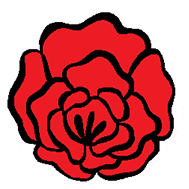Echobo [絵樗蒲 - えちょぼ], also known as Ehonbiki [絵本引 - えほんびき] is a simplified version of Tehonbiki using hanafuda cards, and was played mainly in the Kanto region of Japan. Unlike in Tehonbiki, the dealer does not have to guess what card they have chosen, so the dealer is free to choose the card while looking at it.
It is a simple gambling game where players try to win against the dealer by guessing which one of the first 6 months of hanafuda is chosen by the dealer.
This game was also played around the Aichi prefecture in the Tōkai region of Japan, but instead of hanafuda, a local mekurifuda deck called Ise was used. The game is also called by a different name, Mutsu-ichi [六一, ‘six-one’].
¶ Setup
¶ Equipment
Using a standard 48-card hanafuda deck, up to 4 players may participate in the game (1 dealer and 3 bettors), but any number of players may participate if additional hanafuda decks are used.
- The dealer takes 6 cards- 1
 Pine, 1
Pine, 1  Plum Blossom, 1
Plum Blossom, 1  Cherry Blossom, 1
Cherry Blossom, 1  Wisteria, 1
Wisteria, 1  Iris, and 1
Iris, and 1  Peony. Card types are irrelevant; only the month of the cards are considered.
Peony. Card types are irrelevant; only the month of the cards are considered.
You don’t need to know the month sequence to play the game.
- Each bettor is also given 6 cards corresponding to the same months: Pine, Plum Blossom, Cherry Blossom, Wisteria, Iris, and Peony.
A collection of chips to represent points will also be used.
Next, the dealer needs something to hide the chosen card before the showdown. A white square handkerchief (called kamishita) is traditionally used.
A pen and paper or notepad to keep track of the chosen months of each passing round may be useful.
¶ Ground Rules
Before play begins, the group should agree on the bet size, which is the fixed amount of chips a player could bet on one card.
Also, the group should agree on the maximum number of cards a player can place a bet during one round. In Tehonbiki, 4 cards is the maximum, so it is safe to adopt this number as well.
¶ Choosing the Dealer
No method is stipulated in choosing the dealer, since it is only done in casual games.
Once the dealer is chosen, the remaining players (bettors) seat themselves on the other side of the table opposite the dealer.
If the dealer represents an establishment- say, when playing at a casino or gambling parlour- then their role will obviously be fixed.
¶ Gameplay
¶ Dealer’s Card Selection
The dealer holds six cards in their hand as a stack.
To facilitate choosing the cards, the stack should be in order: The earliest month is on the front, and the latest month is on the back. However, it is not required to do this if you are unfamiliar with the card month sequence.
At the beginning of every round, the dealer hides the cards in hand from the bettors, and cycles through the cards in hand until the card they have chosen is on the front of the stack.
This is traditionally done by skillfully placing the front card on the back of the stack (or the back card on the front of the stack) using one hand only. However, it is not required to do this.
While still hiding the cards from the bettors, the dealer places the stack of cards face up under the white handkerchief, and declares, “It’s in!”.
¶ Betting Round
Bettors then choose a card(s) on their hand they think has the same month as that of the card chosen by the dealer. This is done by placing the card from the hand, along with the chips they bet on that card, to the table face down near them.
A bettor may choose multiple cards to place a bet on.
There are two factors to consider while doing this:
- The number of cards that can be placed bets on is limited as agreed upon before starting the game. (In Tehonbiki, a bettor may only bet on 4 cards in their hand.)
- Each bet placed on each card should be equal to the bet size as agreed upon before starting the game.
Once bettors have finished betting, it’s time for the showdown.
¶ Showdown
The dealer removes the handkerchief, revealing the card that was chosen by the dealer.
Afterward, payments are done based on cards the bettors have placed their bets on:
- Bets placed on the correct card are returned to the bettors. The bettors win 5 times the amount they have bet.
If playing for money, then the bettors only win either 4.5x or 4.6x the bet amount. (The remaining 0.5x or 0.4x is taken by the dealer as a “rental fee” [寺銭 - てらぜん, terazen] for the gambling parlor.)
- Bets placed on the wrong cards are taken by the dealer.
After the payments are done, another round begins. Players play for as many rounds as they want.